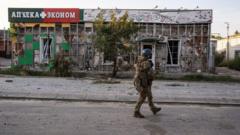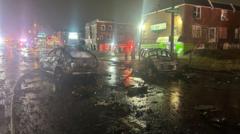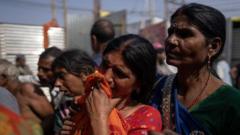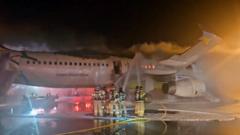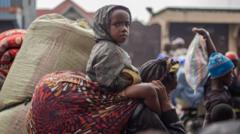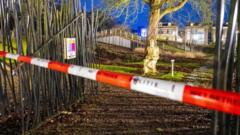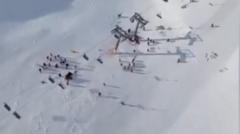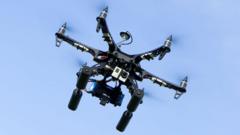In a tragic whirlwind of violence, Kherson's residents recount haunting experiences as drones allegedly target civilians, leaving families shattered and communities paralyzed by fear. The latest reports reveal a significant rise in drone strikes, raising grave concerns about potential war crimes amidst the ongoing conflict in Ukraine.
Russian Drones Target Civilians, Shocking Reports from Kherson Revealed
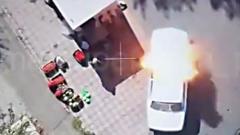
Russian Drones Target Civilians, Shocking Reports from Kherson Revealed
Evidence mounts of Russian drone strikes devastating civilian lives in Ukraine’s Kherson, causing alarm and deep sorrow among residents.
As a hardware trader in Kherson, Serhiy Dobrovolsky never expected his daily life would be upended by a drone attack. On a fateful afternoon, as he conversed with a neighbor, a drone flew overhead, releasing a grenade that claimed his life. This incident is part of a disturbing pattern, with over 30 civilians reported killed and hundreds injured by drone assaults since July 1, according to local military authorities.
The BBC has gathered chilling eyewitness accounts and corroborative evidence suggesting that Russian forces are not only targeting military assets but also explicitly hunting civilians in the city. Angela, Serhiy’s grieving wife, expressed her horror, questioning the intentions behind such brutal acts. "They can see who they are killing," she lamented, hinting at the deliberate nature of these attacks.
Social media platforms have been flooded with videos documenting these horrific events, showcasing the chilling perspective of the drone operators as they track and strike unarmed pedestrians and motorists. One Telegram channel, linked to these videos, has been accused of inciting violence by portraying civilians as legitimate targets.
The drone incursions have instilled a sense of paranoia among residents, who now navigate their daily lives under the constant threat of aerial attack. Strategies to evade detection, such as speeding through the streets or taking cover behind trees, have become essential for survival. Kristina Synia, an aid center worker, described the relentless anxiety as drones hover above, taking note of their movements.
Ben Dusing, who operates the aid facility, noted that the fear spread by drone attacks often immobilizes the population, contrasting with traditional shelling, which at least gives some warning. The use of drones has not only changed the dynamics of warfare but has also turned civilian life into a precarious existence filled with suspense and fear.
Furthermore, recent reports indicate that the Russian military has begun employing drones to disperse mines in populated areas, complicating the already dire situation for Kherson's residents. Oleksandr Tolokonnikov, from Kherson’s military administration, cited concerns about anti-personnel mines that lie hidden, poised to detonate unsuspected victims.
As winter looms, the prospect of drones becoming even more perilous rises, with citizens fearing increased casualties when foliage does not provide cover.
The investigative efforts behind the BBC’s findings involved examining the timeline and locations of the drone attack videos, meticulously matching them with satellite imagery and weather conditions to ensure their validity.
As the conflict in Ukraine continues to escalate, these harrowing accounts from Kherson illustrate the devastating impact of modern warfare on innocent lives, highlighting a growing need for accountability and a re-evaluation of the rules of engagement in conflict zones.
The BBC has gathered chilling eyewitness accounts and corroborative evidence suggesting that Russian forces are not only targeting military assets but also explicitly hunting civilians in the city. Angela, Serhiy’s grieving wife, expressed her horror, questioning the intentions behind such brutal acts. "They can see who they are killing," she lamented, hinting at the deliberate nature of these attacks.
Social media platforms have been flooded with videos documenting these horrific events, showcasing the chilling perspective of the drone operators as they track and strike unarmed pedestrians and motorists. One Telegram channel, linked to these videos, has been accused of inciting violence by portraying civilians as legitimate targets.
The drone incursions have instilled a sense of paranoia among residents, who now navigate their daily lives under the constant threat of aerial attack. Strategies to evade detection, such as speeding through the streets or taking cover behind trees, have become essential for survival. Kristina Synia, an aid center worker, described the relentless anxiety as drones hover above, taking note of their movements.
Ben Dusing, who operates the aid facility, noted that the fear spread by drone attacks often immobilizes the population, contrasting with traditional shelling, which at least gives some warning. The use of drones has not only changed the dynamics of warfare but has also turned civilian life into a precarious existence filled with suspense and fear.
Furthermore, recent reports indicate that the Russian military has begun employing drones to disperse mines in populated areas, complicating the already dire situation for Kherson's residents. Oleksandr Tolokonnikov, from Kherson’s military administration, cited concerns about anti-personnel mines that lie hidden, poised to detonate unsuspected victims.
As winter looms, the prospect of drones becoming even more perilous rises, with citizens fearing increased casualties when foliage does not provide cover.
The investigative efforts behind the BBC’s findings involved examining the timeline and locations of the drone attack videos, meticulously matching them with satellite imagery and weather conditions to ensure their validity.
As the conflict in Ukraine continues to escalate, these harrowing accounts from Kherson illustrate the devastating impact of modern warfare on innocent lives, highlighting a growing need for accountability and a re-evaluation of the rules of engagement in conflict zones.


